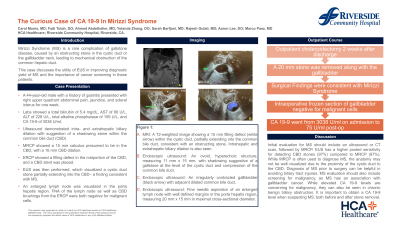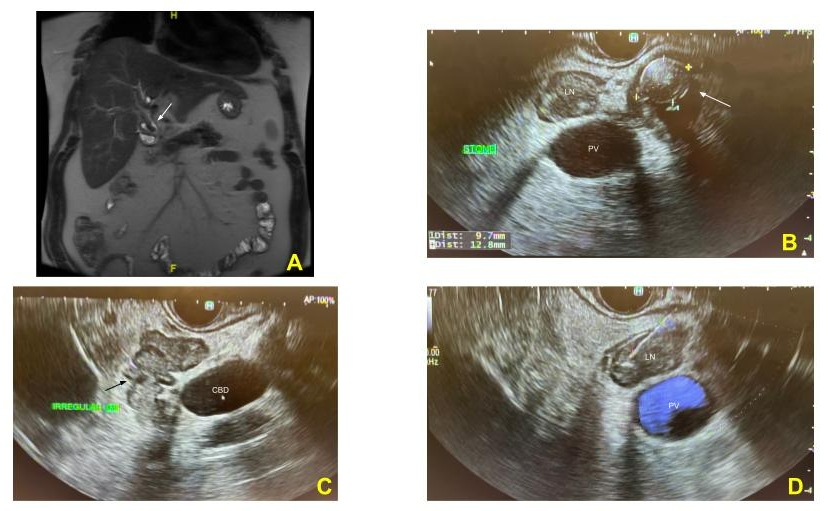Back


Poster Session B - Monday Morning
Category: Biliary/Pancreas
B0032 - The Curious Case of CA 19-9 in Mirizzi Syndrome
Monday, October 24, 2022
10:00 AM – 12:00 PM ET
Location: Crown Ballroom

Has Audio
.jpg)
Carol Monis, MD
HCA Healthcare, Riverside Community Hospital
Riverside, CA
Presenting Author(s)
Carol Monis, MD1, Fadi Totah, DO1, Ahmed Abdelhalim, MD2, Yolanda Zhang, DO3, Sara Barfjani, MD3, Rajesh Gulati, MD3, Aaron Lee, DO3, Marco Paez, MD3
1HCA Healthcare, Riverside Community Hospital, Riverside, CA; 2Harbor-UCLA Medical Center, Torrance, CA; 3Riverside Community Hospital, Riverside, CA
Introduction: Mirizzi Syndrome (MS) is a rare complication of gallstone disease, caused by an obstructing stone in the cystic duct or the gallbladder neck, leading to obstruction of the common hepatic duct. This case discusses the utility of EUS in improving diagnostic yield of MS and the importance of cancer screening in these patients.
Case Description/Methods: A 44-year-old male with a history of gastritis presented with right upper quadrant (RUQ) abdominal pain, jaundice, and scleral icterus for one week. On exam, the patient was afebrile with mild RUQ abdominal tenderness. Labs showed a total bilirubin of 5.4 mg/dL, AST of 66 U/L, ALT of 228 U/L, and a total alkaline phosphatase of 159 U/L. Ultrasound demonstrated intra- and extrahepatic biliary dilation with suggestion of a shadowing stone within the common bile duct (CBD). The gallbladder wall was thickened with trace pericholecystic fluid. MRCP showed a 15 mm calculus presumed to be in the CBD, with a 16 mm CBD dilation. ERCP showed a filling defect in the midportion of the CBD, and a CBD stent was placed. Due to these findings, a CA 19-9 antigen was drawn, measuring 3038 U/mL. EUS was then performed, which visualized a cystic duct stone partially extending into the CBD– a finding consistent with MS. An enlarged lymph node was visualized in the porta hepatis region. FNA of the lymph node as well as CBD brushings from the ERCP were both negative for malignant cells. The patient was discharged and underwent a cholecystectomy two weeks later. Surgical findings were consistent with MS and a 20 mm stone was removed with the gallbladder. The intraoperative frozen section of the gallbladder was negative for malignant cells.
Discussion: Initial evaluation for MS should include an ultrasound or CT scan, followed by MRCP. The pooled sensitivity of MRCP for detecting CBD stones is around 87%. While MRCP is often used to diagnose MS, the anatomy may not be well visualized due to the proximity of the cystic duct to the CBD. EUS has a pooled sensitivity of 97% in detecting a CBD stone and can better visualize the biliary tract anatomy, aiding in diagnosis. Diagnosis of MS prior to surgery can be helpful in avoiding biliary tract injuries. MS evaluation should also include screening for malignancy, as MS has an association with gallbladder cancer. While elevated CA 19-9 levels are concerning for malignancy, they can also be seen in chronic benign biliary obstruction. It is important to obtain a CA 19-9 level when suspecting MS, both before and after stone removal.

Disclosures:
Carol Monis, MD1, Fadi Totah, DO1, Ahmed Abdelhalim, MD2, Yolanda Zhang, DO3, Sara Barfjani, MD3, Rajesh Gulati, MD3, Aaron Lee, DO3, Marco Paez, MD3. B0032 - The Curious Case of CA 19-9 in Mirizzi Syndrome, ACG 2022 Annual Scientific Meeting Abstracts. Charlotte, NC: American College of Gastroenterology.
1HCA Healthcare, Riverside Community Hospital, Riverside, CA; 2Harbor-UCLA Medical Center, Torrance, CA; 3Riverside Community Hospital, Riverside, CA
Introduction: Mirizzi Syndrome (MS) is a rare complication of gallstone disease, caused by an obstructing stone in the cystic duct or the gallbladder neck, leading to obstruction of the common hepatic duct. This case discusses the utility of EUS in improving diagnostic yield of MS and the importance of cancer screening in these patients.
Case Description/Methods: A 44-year-old male with a history of gastritis presented with right upper quadrant (RUQ) abdominal pain, jaundice, and scleral icterus for one week. On exam, the patient was afebrile with mild RUQ abdominal tenderness. Labs showed a total bilirubin of 5.4 mg/dL, AST of 66 U/L, ALT of 228 U/L, and a total alkaline phosphatase of 159 U/L. Ultrasound demonstrated intra- and extrahepatic biliary dilation with suggestion of a shadowing stone within the common bile duct (CBD). The gallbladder wall was thickened with trace pericholecystic fluid. MRCP showed a 15 mm calculus presumed to be in the CBD, with a 16 mm CBD dilation. ERCP showed a filling defect in the midportion of the CBD, and a CBD stent was placed. Due to these findings, a CA 19-9 antigen was drawn, measuring 3038 U/mL. EUS was then performed, which visualized a cystic duct stone partially extending into the CBD– a finding consistent with MS. An enlarged lymph node was visualized in the porta hepatis region. FNA of the lymph node as well as CBD brushings from the ERCP were both negative for malignant cells. The patient was discharged and underwent a cholecystectomy two weeks later. Surgical findings were consistent with MS and a 20 mm stone was removed with the gallbladder. The intraoperative frozen section of the gallbladder was negative for malignant cells.
Discussion: Initial evaluation for MS should include an ultrasound or CT scan, followed by MRCP. The pooled sensitivity of MRCP for detecting CBD stones is around 87%. While MRCP is often used to diagnose MS, the anatomy may not be well visualized due to the proximity of the cystic duct to the CBD. EUS has a pooled sensitivity of 97% in detecting a CBD stone and can better visualize the biliary tract anatomy, aiding in diagnosis. Diagnosis of MS prior to surgery can be helpful in avoiding biliary tract injuries. MS evaluation should also include screening for malignancy, as MS has an association with gallbladder cancer. While elevated CA 19-9 levels are concerning for malignancy, they can also be seen in chronic benign biliary obstruction. It is important to obtain a CA 19-9 level when suspecting MS, both before and after stone removal.

Figure: Figure 1. A. MRI: A T2-weighted image showing a 15 mm filling defect (white arrow) within the cystic duct, partially extending into the common bile duct, consistent with an obstructing stone. Intrahepatic and extrahepatic biliary dilation is also seen. B. Endoscopic ultrasound: An ovoid, hyperechoic structure, measuring 11 mm x 15 mm, with shadowing suggestive of a gallstone at the level of the cystic duct and compression of the common bile duct. C. Endoscopic ultrasound: An irregularly contracted gallbladder (black arrow) with adjacent dilated common bile duct. D. Endoscopic ultrasound: Fine needle aspiration of an enlarged lymph node with well defined margins in the porta hepatis region, measuring 20 mm x 15 mm in maximal cross-sectional diameter. Color Doppler imaging was utilized prior to needle puncture to confirm a lack of significant vascular structures within the needle path.
Disclosures:
Carol Monis indicated no relevant financial relationships.
Fadi Totah indicated no relevant financial relationships.
Ahmed Abdelhalim indicated no relevant financial relationships.
Yolanda Zhang indicated no relevant financial relationships.
Sara Barfjani indicated no relevant financial relationships.
Rajesh Gulati indicated no relevant financial relationships.
Aaron Lee indicated no relevant financial relationships.
Marco Paez indicated no relevant financial relationships.
Carol Monis, MD1, Fadi Totah, DO1, Ahmed Abdelhalim, MD2, Yolanda Zhang, DO3, Sara Barfjani, MD3, Rajesh Gulati, MD3, Aaron Lee, DO3, Marco Paez, MD3. B0032 - The Curious Case of CA 19-9 in Mirizzi Syndrome, ACG 2022 Annual Scientific Meeting Abstracts. Charlotte, NC: American College of Gastroenterology.
